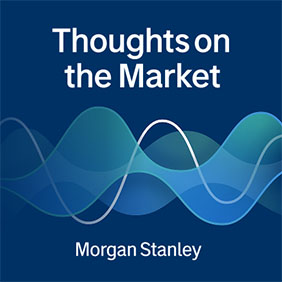Lessons From a Bond Issued 90 Years Ago
October 9, 2025
Diving into the history of Morgan Stanley’s first bond deal, our Head of Corporate Credit Research Andrew Sheets explains the value of high-quality corporate bonds.

-
 Andrew Sheets
Andrew Sheets
Thoughts on the Market
Listen to our financial podcast, featuring perspectives from leaders within Morgan Stanley and their perspectives on the forces shaping markets today.

Up Next
When Will the Shutdown Affect Markets?
Transcript
Welcome to Thoughts on the Market. I'm Michael Zezas, Global Head of Fixed Income Research and Public Policy Strategy.
Today: Three checkpoints we’re watching for as the U.S. government shutdown continues.
It’s Wednesday, October 8th at 10:30am in New York.
The federal government shutdown in the United States has crossed the one week mark. But if you’re watching the markets, you might be surprised at how calm everything seems. Stocks are steady. Bond yields haven’t moved much, and volatility’s low.
It’s more or less the scenario my colleague Ariana and I had talked about in anticipation of the impasse in Washington. We’d noted the potential for uncertainty for investors and market reaction depending on how long the shutdown would last.
So that raises a big question: what, if anything, about this government shutdown could shake investor confidence and start moving markets?
The question is worth considering. Prediction markets now suggest the most likely outcome is that the government shutdown will not end for at least another week. And as we’ve seen in past shutdowns, the longer it drags on, the more likely it is to matter. That’s because risks to the economic outlook start to accumulate, and investors eventually have to start pricing in a weaker growth outlook.
There’s a few checkpoints we’re watching for – for when investors might start feeling this way.
First, the missed paycheck for furloughed federal workers. The first instance of this comes in a few days. Less pay naturally means less spending. Studies suggest that spending among affected workers can drop by two to four percent during a shutdown. That’s not huge for GDP at first — but it’s a sign the shutdown is having effects beyond Washington, DC.
Second, this time might be different because of potential layoffs. The administration has hinted that agencies could move to permanently cut staff — something we haven’t seen before. Unions have already said they’d challenge that in court. But if those actions start, or even if legal uncertainty grows around them, it could raise the economic stakes.
Third, we’re watching for real disruptions to economic activity resulting from the shutdown. The last shutdown ended when air traffic in New York was curtailed due to a shortage of air traffic controllers. We’re already seeing substantial air traffic delays across the country. More substantial delays or ground halts obviously impede economic activity related to travel. And if such actions don’t coincide with signals from DC of progress in negotiating a bill to reopen the government, investors’ concern could grow.
So here’s the bottom line: markets may be right to stay calm — for now. But the longer this shutdown lasts, the more likely one of these pressure points pushes investors to rethink their optimism.
Thanks for listening. If you enjoy Thoughts on the Market, please leave us a review and tell your friends about the podcast. We want everyone to listen.

Get Ready for a Steeper Yield Curve
Transcript
Vishy Tirupattur: Welcome to Thoughts on the Market. I am Vishy Tirupattur, Morgan Stanley’s Chief Fixed Income Strategist.
Today – How the shape of the yield curve has affected credit and housing markets, and the risk of changes to the curve and its implications.
It’s Tuesday, October 7th at 1pm in New York.
The shape of the yield curve plays a pivotal role in financial markets. It influences everything from credit conditions to housing and mortgage dynamics. And you’ve been hearing on this show for some time about more Fed rate cuts coming. Our economists expect 25 basis point rate cuts at the next three meetings – that is October, December and January. And then two more in April and July of next year.
What does this mean to the shape of the curve? Our high conviction call has been that investors should position for a steeper yield curve. Why does the curve matter? It’s not just a macro signal. It’s a transmission mechanism that shapes pricing, risk appetite, and sector flows.
Take life insurers, for example. A steeper curve has turbocharged demand for fixed annuity products, which in turn drives flows into spread assets like corporate and securitized credit. Insurance demand has become a powerful technical in credit markets.
This year’s steepening has been led by falling front-end yields. For example, 2-year Treasuries are down about 60 basis points, significantly outpacing the 40 basis point drop in 10-year yields and just 5 basis point drop in 30-year yields. That front-end move reflects shifting rate expectations and offers relief to highly leveraged issuers who rely on short-term funding.
But longer-dated yields remain sticky, keeping all-in borrowing costs elevated. That is good for insurers – and the sale of fixed annuity products – but acts as a brake on overall issuance, helping keep credit spreads tight despite macro uncertainty.
That said, not all markets benefit. Mortgage rates, which track longer yields more closely than the fed funds rate, have actually risen 25 to 30 basis points since the easing cycle began in September of 2024. That’s a headwind for affordability. While a steeper curve may support lending and future housing supply, it’s not helping today’s buyers. A flatter curve with lower long-end yields would offer more meaningful relief—but that is clearly not our base case.
Bottom line: Rate cuts matter, but the shape of the curve may matter more. A steeper curve is a tailwind for credit but a headwind for housing. And a reminder that not all markets move in sync.
Thanks for listening. If you enjoy the show, please leave us a review wherever you listen and share Thoughts on the Market with a friend or colleague today.

Sign up to get Morgan Stanley Ideas delivered to your inbox.
Thank You for Subscribing!
Would you like to help us improve our coverage of topics that might interest you? Tell us about yourself.



